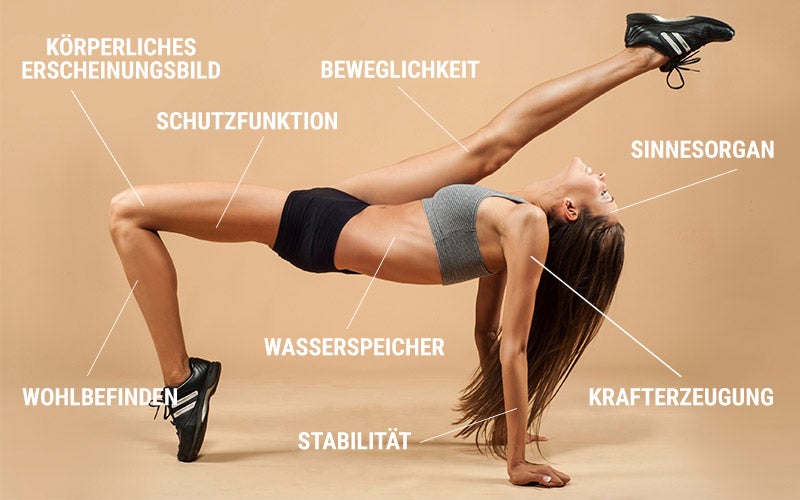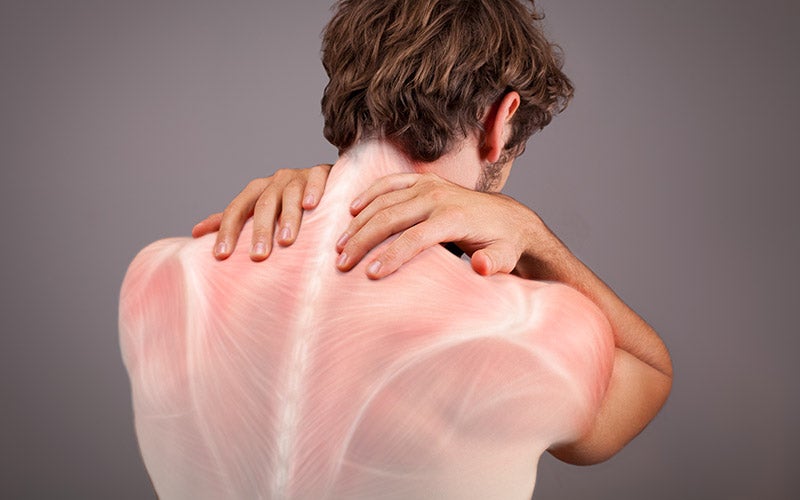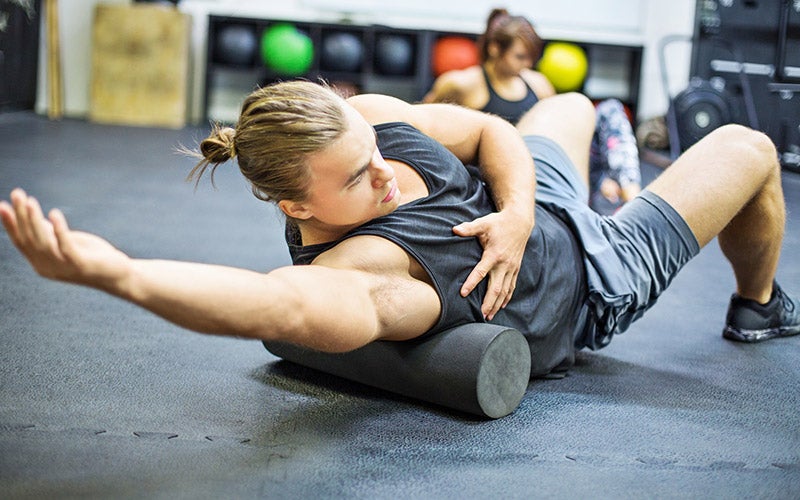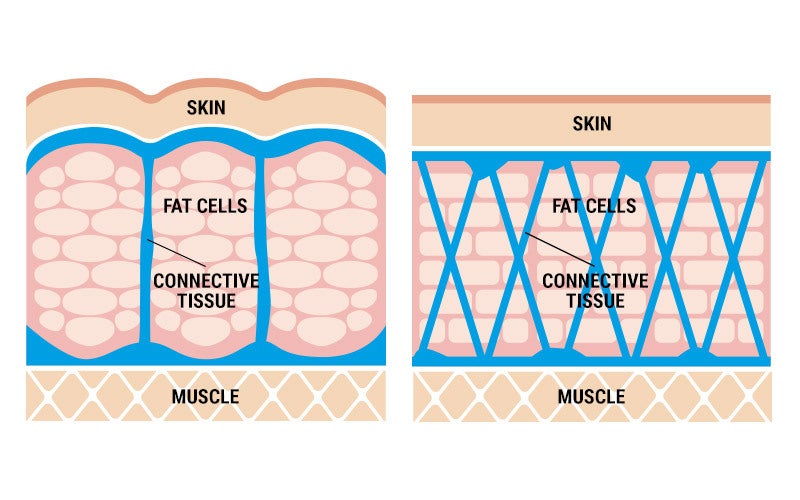Fascia: What You Need to Know About Your Connective Tissue!
 ©Augustas Cetkauskas / EyeEm
©Augustas Cetkauskas / EyeEm
There’s been a lot of hype about fascia and it’s not slowing down. Training your fascia fights cellulite and can improve your whole body’s appearance and movement. Does it work? What else can fascia do?
What are fascia?
Have you ever had to remove a thin white film from a piece of meat while preparing it? That was a piece of fascia. These translucent, stringy, milky-white tissues don’t look like anything spectacular at first glance.
The word comes from the Latin and can be translated as “band,” “bundle” or “bandage.” In simple terms, we are talking about connective tissue.
Your fascia consist of collagen fibers, water and adhesive matter and are only 0.5 to 3 millimeters thick. They run all through your body, linking muscles, organs, blood vessels, bones, ligaments and even your brain. Without this netlike web running throughout the body, you would simply collapse.

Several continuous fascia tracts run through your whole body. These are made up of a chain of muscles, tendons and fascia. They are responsible for all your body’s movements, from start to finish.
Fascia can be divided into 3 groups:
- Superficial fascia are found just under the skin. They connect your organs and your other tissues. They surround your blood vessels, nerves and glands. They retain fat and water.
- Deep fascia are the densest layers. They surround and connect your muscles, bones and joints. The deep fascia respond to chemical and mechanical stimuli, and they are also thought of as the sixth sensory organ.
- Visceral fascia surround and protect your organs. They hold and keep them in place.
The essentials:
This netlike system surrounds your organs, muscles, blood vessels, bones, tendons and ligaments. It holds the human body together and keeps all its parts in place.
Functions and Tasks
Different fascia have very different functions in your body. These include:
- Barrier: Forms a barrier between muscles, organs, and the tissue and bone surrounding them. Keeps everything in its place. Reduces friction between muscles.
- Transmission: Transfers forces from muscle to muscle.
- Force memory: Saves forces to be released later, like a spring.
- Transport and supply: Lymphatic fluid, also part of the connective system, transports the building blocks as well as the byproducts of cells around the body.
- Protection: Surround and protect organs and muscles.
- Defense: Fascia protect your body from pathogens.
- Storage: Fascia also store water.
- Communication: Relay messages between blood vessels and nerves.
- Agility: Are responsible for your overall mobility.
- Sensory organ: Respond to mechanical and chemical stimuli and relays them to your brain.
- Shock absorbing: Absorb the shock of counteracting forces like a spring.
- Appearance: Shape and form your physical appearance.
- Health: Influence your physical and mental well-being.

The essentials:
Fascia can protect or separate. They are involved in transmitting and generating force. They determine your overall flexibility and your physical appearance. They store water and protect your body from invading pathogens.
Why do fascia adhere to each other?
Fascia that stick together, or adhere, are not only painful but can also lead to muscle tension and an increased risk of injury.
There are several reasons fascia adhere. First off, fascia adhesion increases as we age. The fascia are able to retain less and less water, and elasticity decreases. Dehydration in general also causes your fascia to stick together.
However, one of the main causes of adhesion is a lack of exercise and poor posture. Constant sitting prevents a healthy lymphatic flow. Lymphatic fluid transports fibrinogen, a natural adhesive the body uses to seal wounds. When the lymph doesn’t flow, fibrinogen doesn’t move, and this idle fibrinogen can stick your fascia together.

Constant stress and lack of sleep can alter your hormone balance. These behaviors release more stress hormones, which puts your fascia under constant tension. Another factor that can make your fascia tight is eating a diet that is too acidic, which causes acidification inside your body. This changes the shape of your fascia, causing them to develop a gel-like consistency. Movement and transport functions no longer work properly. The fascia end up storing a slurry of byproducts.
The consequence: Your fascia stick together.
Health consequences
If fascia are unable to perform their functions, it can have far-reaching consequences for your entire body. Muscles, ligaments, tendons, joints and organs are affected. You lose flexibility. Back pain, shoulder pain, neck pain, joint pain and tendon irritation or inflammation often occur.
Consequences for your muscles
Your muscles are not the only body part responsible for your body’s movement. Your fascia play a big role here. Hardened fascia can restrict your mobility. They make you more prone to injury in everyday life as well as when doing sports.

You’ll see less progress in your training, as you won’t be able to use your full range of motion. You might experience body stiffness. And there’s a higher chance of changing your posture to compensate or developing bad posture.
Consequences for your organs
Twisted and matted fascia can lead to pinched nerves, which can cause severe pain. Your blood vessels are not able to move as much blood. The constrictions affect the communication between your nerve cells and your brain.
They affect your lymphatic flow. Side effects can include swollen eyes and heavy legs, and range all the way to swelling and chronic diseases.
Your organs receive a worse supply of the nutrients they need. Byproducts produced by your organs are no longer transported properly. If your organs spend too long not getting what they need, they can no longer function properly. This can lead to heart, breathing and digestive issues.
The essentials:
Lack of water and exercise causes your fascia to stick together. Your mobility is restricted. You become more susceptible to injuries. Adhered fascia can lead to tension and nerve pain. Your organs will be poorly supplied and, in the worst cases, will no longer be able to fully function!
Release adhesions – fascia training and exercises
Training your fascia protects you from muscular injury and keeps your body in shape. It tightens your connective system. Your tendons and ligaments become more resilient. And it can prevent pain, such as in the shoulder or back. Even painful friction in joints is reduced.
Fascia adapt to stresses and stimuli. They can be trained in different ways in order to release adhesion and hardening. It takes time to train your fascia. Fascia take longer to adapt to stress stimuli; fascia fibers are changed out one by one as the structure of your fascial network gets rebuilt. This process can take up to several months.
Exercises for your fascia
Apart from the classic options of fascia therapy in a physical therapy or osteopathy setting, there are also lots of helpful moves that you can work into your training..

1. Stretching
One option is long-chain and dynamic stretching, which stretches not just one muscle, but a group of muscles. As you stretch, perform light swinging movements to help your fascia remain supple and elastic. This reduces your risk of injury in everyday life as well as sports.
2. Bouncing moves
Elastic, spring-like movements such as bouncing and jumping also train and strengthen your fascia. This type of movement stimulates your collagen production.
3. Fascia roll and massage
Massages, such as with a fascia roll, can also be helpful. The self-massage stimulates the cells in your connective tissue and encourages blood circulation. Using a fascia roll gives your muscles a “sponge effect,” meaning it promotes fluid exchange around the body.

Our tip: Using a fascia roll can be very painful. Do not go beyond your pain tolerance limit. It’s best to make yourself familiar with the correct technique.
4. Fascia yoga and Pilates
Due to their bouncing, complex, and stretching exercises, yoga and Pilates are also a good option to help take care of your fascia.
Fascia training plan
You must be wondering how you are ever going to fit fascia training in alongside your life and your other fitness plans. Don’t worry! Fascia training doesn’t need big chunks of time. Short periods are enough.

The dynamic stretching exercises can be integrated into your warmup. When you’re done working out, spend a few minutes rolling yourself out with a fascia roll. Or just build a handful of jumping or bouncing movements into your everyday life. It’s easy to do a few jumping jacks while you’re waiting for a meeting or your next ride.
The essentials:
It only takes a few minutes every day to train your fascia. Stretching exercises, bouncing movements, massages, fascia rolls, fascia yoga and Pilates are especially helpful.
Influence of nutrition – nutrition tips
Just like with strength training, training your fascia is only one side of the coin. You will get the best results if your nutrition matches up with your training goals.
The wrong diet can lead to acidification of your fascia. In this case, eat more alkaline foods. These support the regeneration of your connective tissue and even out your acid-base balance. Need some ideas of alkaline foods? Check out our article on alkaline foods for tips.
Fascia are made of collagen, a structural protein. If your protein intake is lacking, your fascia will not be able to carry out their crucial functions. Your connective tissue won’t be able to regenerate, heal or grow. Proteins are not only good for your muscles, but also for your fascia.
Our tip: Are you having trouble getting enough protein? Our Whey Protein provides you with 24 grams of protein per serving.
Whey to go! Try our Whey Protein
For our plant-based friends and fans, our Vegan Protein serves up 20.7 grams of protein per serving.
Your body also needs the amino acid lysine to make collagen. It’s found in whole-grain products, walnuts, quinoa, buckwheat, and dairy products.
Don’t forget to keep up a good supply of micronutrients, either. Zinc and vitamin C are necessary to make new collagen.
Your fascia consist of up to 75% water. Drink at least 8-12 glasses (half a gallon) of water a day to keep your fascia fully hydrated.
The essentials:
Take advantage of a combination of training and nutrition. Watch your acid-base balance. Make sure you get enough micronutrients, such as vitamins, minerals and trace elements. Drink 8-12 glasses of water a day. Provide your body with complex carbohydrates, healthy fats and enough protein.
Fascia training to counteract cellulite
Cellulite, dents in the skin and orange-peel skin come about through a mix of genetic conditions, weak connective tissue and fat deposits. But why do women have more cellulite than men?
Because their fascia are structured differently. In men, the fascia run crisscross to each other; in women, however, they run in parallel columns. This column-like structure makes women’s skin more susceptible to that cellulite appearance. Fat cells push up through the spaces between the columns. Voila – dents and cellulite.

Targeted training stimulates your connective tissue. It responds by producing more collagen fibers, which make the existing fascia stronger and firmer. The fat cells have a harder time pushing up between the columns of fascia. A balanced combination of strength training, fascia training and nutrition can reduce cellulite and improve your skin’s appearance.
The essentials:
Women’s connective tissue is structured differently than men’s and therefore more susceptible to bumps and dents. Fascia training tightens it and can thus reduce cellulite.
Our Conclusion
- Fascia hold us together like a net and shape the way we look.
- Fascia have many important functions in the body.
- Adhered and hardened fascia have serious consequences for your entire body.
- You can train your fascia with stretching, jumping, bouncing exercises, massage, yoga or Pilates.
- Fascia training is easy to work into your everyday life.
- Eat good carbohydrates, healthy fats and enough protein.
- Make sure to get a proper supply of micronutrients.
- Training your fascia can reduce cellulite.
Sources for this article
We at foodspring use only high-quality sources, including peer-reviewed studies, to support the facts within our articles. Read our editorial policy to learn more about how we fact-check and keep our content accurate, reliable, and trustworthy.





























